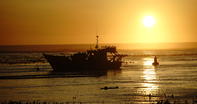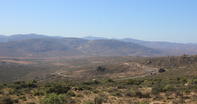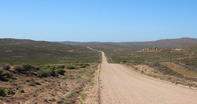Limited Routes
The biggest problem facing the copper mines of Namaqualand was the lack of effective transport routes. The region had few roads, and those that did exist were in a terrible state.

The heavy ore couldn’t be profitably transported overland to Cape Town and the Orange River wasn’t an option. This meant that the rocks had to be taken to the sea (about 120 km away) and then shipped down to Cape Town, from whence it could be sent to England. But this required the establishment of a port on the hostile coastline.
Accordingly, in 1854, Captain H.J. Nolloth surveyed the entire Namaqualand coast up to the Orange River mouth. He declared that there were two potential anchorages, although neither was particularly good. Both had an outer anchorage about a mile from the shore and an inner anchorage (for smaller boats) with a pronounced sandbar.
They were called Hondeklip Bay and Robbe Bay (Bay of Seals), and the good captain’s preference was for the latter, which was soon re-named Port Nolloth in his honour.
The Copper Rider

For the mines clustered around Springbok, 120 km away from the coast, neither was ideal as the overland routes to reach these harbours each had their own problems. The Hondeklip Bay road was very mountainous, while the Port Nolloth route had a poor supply of water for the draught animals.
Furthermore, while both routes had to traverse the western Hardeveld Mountains and then cross a strip of soft, deep sand (which was a nightmare for the heavy wagons), the Port Nolloth route had a wider expanse of Sandveld to negotiate. And so, in 1852, the first shipment of 11 tons of ore was sent by wagon over the rough path to Hondeklip Bay.
This tortuous route quickly became the preferred route to the sea, and a new profession was born to take on the challenge – the era of the copper rider had begun. Despite the best efforts of the copper riders, who were local farmers of various ethnic groups, the problems with the primitive road were manifest. Sacks of ore burst open. Wagons fell to pieces.
Water for the animals was scarce. Wheels got stuck in the sand. And it was slow going. Each journey to the coast took roughly 6 days, and another 4 days to get back.
A Procession

Nevertheless, a procession of heavily laden wagons, each weighing up to one and a half tons, soon began bumping along the rough gravel path (although many wagons arrived at the coast about 500 kilograms lighter as a result of ore falling off en route). By 1866, there were about 300 wagons and 6000 draught animals plying the route.
Most of these wagons were hauled by sorry asses, arranged together in teams of up to 10 mules. In times of good rain, oxen were used. The copper riders also tried using Scotch carts, but these light-weight vehicles couldn’t withstand the battering. The geologist-surveyor, Wyley, even suggested importing camels to use as draught-animals during the dry summer months.
While this is a somewhat ridiculous idea, it’s not as bad as an earlier idea, expressed in 1802, that proposed using giraffes!
By David Fleminger